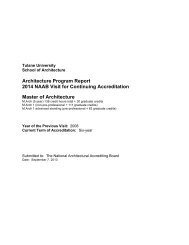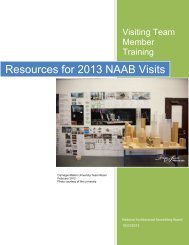Architecture Program Report Tulane University New Orleans ...
Architecture Program Report Tulane University New Orleans ...
Architecture Program Report Tulane University New Orleans ...
You also want an ePaper? Increase the reach of your titles
YUMPU automatically turns print PDFs into web optimized ePapers that Google loves.
core design sequence (DSGN 110 through 320). URBANbuild at the<br />
microscale also gives students opportunity to employ structural systems to<br />
“real world” hands-on structural design projects, while Thesis (DSGN<br />
510/520), specifically Professor Coleman Coker’s GREENbuild thesis<br />
studio, does the same.<br />
Yet it should be noted that the attention to structures is a fundamental<br />
component of the Design Studio environment; several faculty have an<br />
expressed interest in the capacities of structural systems and this interest<br />
is reflected in studio programs across the curriculum.<br />
19. Environmental Systems<br />
Understanding of the basic principles and appropriate application and<br />
performance of environmental systems, including acoustical, lighting, and<br />
climate modification systems, and energy use, integrated with the building<br />
envelope.<br />
These issues are introduced in the first year, specifically in the design<br />
studios. They continue to be emphasized in the core studios. However, the<br />
main thrust of teaching environmental systems lies with the technology<br />
sequence, specifically the courses ATCS 110 and ATCS 320 (Technological<br />
SystemsI & III) and the Integrated Technologies sequence (ATCS 410:<br />
Integrated Technologies I and ATCS 420: Integrated Technologies II).<br />
20. Life Safety<br />
Understanding of the basic principles of life-safety systems with an<br />
emphasis on egress.<br />
This material is first taught at the beginning of the Design Studio sequence<br />
(DSGN 110, 120), and continues to inform the development of DSGN<br />
attributes. Life Safety is introduced in the first Technological Systems<br />
course (ATCS 110). It is more specifically covered in the Integrated<br />
Technologies courses (ATCS 410 and 420), one of which is attached to the<br />
comprehensive design studio (DSGN 324/ATCS 420). The material is also<br />
covered in the URBANbuild microscale and macroscale studios held during<br />
the fourth year, as well as in the design/build studios (in the fourth year<br />
also).<br />
It should also be noted that, given the fact that most of the design studio<br />
faculty are active practitioners, the attention to life-safety concerns is a<br />
prominent aspect of the Design Studio sequence.<br />
In addition, life-safety as a significant component of the architect’s<br />
responsibility is treated in the required Concerns of the Profession course<br />
(APFC 410).<br />
Additional opportunities for the study and application of life-safety systems<br />
and their subsystems is found in the Preservation Studies courses (PRST<br />
series). This is due to the fact that many historic buildings do not<br />
accommodate modern codes or uses; the appropriation of new uses<br />
requires an attention to this issue as fundamental consideration in the














